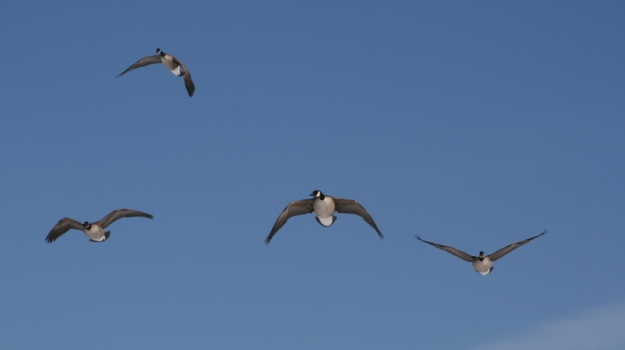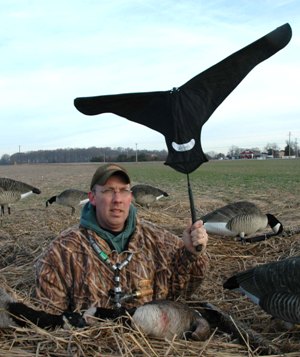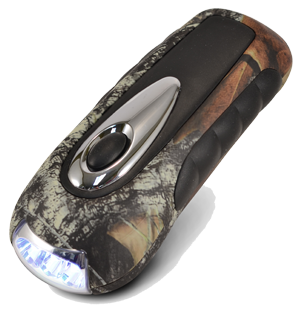
Editor’s Note: Cory Dukehart of Westminster, Maryland, is an avid waterfowler and Mossy Oak’s Atlantic flyway Regional Pro Staff Manager.
When you're hunting on the Eastern Shore for migrating flyway Canada geese, you'll be competing with many other hunters who want to take those same geese. I believe there’s strength in numbers when hunting geese, especially when you're hunting places with high hunter pressure. So, we’ll put out big spreads of 14- to 16-dozen decoys. Our spread will include full-body decoys, windsocks and silhouettes. I like the Bigfoot full-body decoys, and I like the Real Geese silhouette decoys.
We want to use as many different callers as possible. When you have a large spread of decoys, you need as many hunters as you can blowing goose calls. We want our callers to be clucking, moaning and calling loudly to sound like as many different geese as we possibly can. We want to paint a picture in the mind of the geese that are in the air. We want them to think that the decoys they see are relaxed geese, having a good time feeding, talking to each other and more or less having a picnic, so, the geese won’t flare off or be nearly as wary. I use the Buck Gardner goose calls and duck calls.
When we hunt flyway geese, we hunt from pits. Occasionally, we do use ground blinds, but we've found that we can be far more productive hunting from goose pits, instead of ground blinds. Usually, we have four to five hunters in a pit. Everyone in my hunting party wears Mossy Oak Shadow Grass Blades camo. I don’t believe there's another waterfowl pattern that even comes close to Mossy Oak Shadow Grass Blades camo, since it’s such a very versatile pattern. Quite a few of my friends wear this pattern to hunt whitetails and Sitka deer on the Eastern Shore of Maryland in the marshy areas. Many people come to the Eastern Shore to hunt, because rarely will there be a time when you can’t see several flights of geese in the air when you look up.
 Resident Geese:
Resident Geese:
Although I use the same kind of decoys when I'm hunting for resident geese, I don’t use nearly as many decoys in my spread as I do when I'm hunting the Eastern Shore. I’ll usually put out half as many decoys when I'm hunting in western Maryland for resident geese, as I put out when I'm hunting in eastern Maryland for flyway geese. Not as many geese are available on the western side of the state as on the eastern side of the state. Since these flocks are usually smaller, I don’t need as many decoys in the spread.
When we drive around the fields and scout for resident geese, we’ll usually only see 20 to 40 birds in any one field. When you’re scouting on the Eastern Shore, and you spot Canada geese out in the fields, those flocks usually will contain 150 to 200 birds. We try to make our decoy spread look like the flocks we see feeding in the fields, whether we’re hunting flyway geese or resident geese. Because we’re using fewer decoys, when we’re hunting resident geese, we call far less than when hunting flyway geese. I’ll use the same notes and the same cadence for resident geese as I use for flyway geese, but I won’t call nearly as much to the resident geese as I do the flyway geese. I depend more on my motion decoys to get the geese’s attention. We also flag the geese. We wave the flags to look like geese trying to land.
The geese are usually feeding in corn fields, but we also find geese in soybean fields, especially in the early part of goose season. We've found that the geese like to feed on soybeans that have been spilled in the field in the early season, because these beans probably have been rained on, and they're somewhat soggy, making the soybeans easier for the geese to eat. Once our region has a cold freeze, and the ground and beans freeze-up, the geese are reluctant to go to the bean fields. We hunt corn fields in the western part of the state about 75 to 80 percent of the time and also winter wheat. When we’re hunting for resident geese, we can get our limit if we’re hunting the right fields. But more time may be required to limit out on resident geese than flyway geese. Of course, we’re taking five resident geese per day, and we’re only taking two geese when we’re hunting flyway geese. We often laugh and say, “We spend more time putting out our decoys in the flyway geese zone than we spend shooting the geese.”
I've hunted waterfowl in Canada and states all across the U.S. I’ll put our Eastern Shore goose hunts up against any of them. I've never been to an area where we can take more geese quicker than on Maryland’s Eastern Shore. If you like a mixed trip by hunting sea ducks or puddle ducks early in the morning and still getting a limit of geese before dark, come to Maryland. The sea duck hunting is usually better than the puddle duck hunting.






























